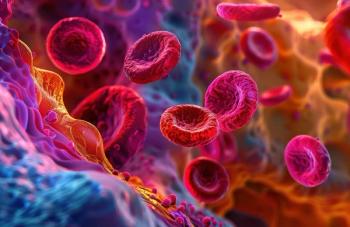
Study Explores Brentuximab Vedotin Efficacy in Patients Expressing High CD30 Levels
A recent study explored the efficacy of brentuximab vedotin (BV) in patients with high-CD30–expressing non-Hodgkin lymphoma (NHL) to determine who is most likely to benefit.
A recent study explored the efficacy of brentuximab vedotin (BV) in patients with high-CD30—expressing non-Hodgkin lymphoma (NHL) to determine who is most likely to benefit.
The phase 2 trial enrolled relapsed or refractory high-CD30—expressing NHL, with BV administered intravenously at 1.8 mg/kg every 3 weeks. The primary endpoint was a disease control rate of more than 40%, consisting of complete response (CR), partial response (PR), or stable disease.
BV (sold under the name Adcetris) has several FDA approvals, including for use in combination with chemotherapy for adult patients with certain types of peripheral T-cell lymphoma (PTCL); the treatment of adult patients with previously untreated stage 3 or 4 classical Hodgkin lymphoma (HL); systemic anaplastic large cell lymphoma (ALCL) after failure of at least 1 prior multi-agent chemotherapy regimen; and primary cutaneous anaplastic large cell lymphoma or CD30-expressing mycosis fungoides (MF).
The efficacy of BV has previously been evaluated in various subtypes of NHL, including diffuse large B-cell lymphoma (DLBCL), primary mediastinal B-cell lymphoma (PMBCL), peripheral T-cell lymphoma (PTCL), MF, and various cutaneous T-cell lymphomas. These studies enrolled patients with a wide range of CD30 expression levels, and their response rates were unrelated to the CD30 expression level of tumor cells.
High CD30 expression was defined as 30% or greater tumor cells positive for CD30 by immunohistochemistry. CD30 is uniformly expressed in HL and ALCL.
The purpose of the study was to determine the overall disease control rate from BV administration among heavily pretreated relapsed or refractory patients with various subtypes of NHL, other than ALCL and HL. Because the study sample was based on CD30-positive tumor cells being equal to or greater than 30%, regardless of histologic subtype, patients with various subtypes of NHL, from DLBCL to MF, could enroll. High-CD30-expressing NHL patients (n = 33) were enrolled, except for those with ALCL.
The disease control rate was 48.5% (16/33) including 6 CR and 6 PR; 6 patients (4 CR, 2 PR) maintained their response over 16 completed cycles. Response to BV and survival were not associated with CD30 expression levels.
Over a median of 29.2 months of follow-up, the median progression-free and overall survival rates were 1.9 months and 6.1 months, respectively. The most common adverse events were fever (39%), neutropenia (30%), fatigue (24%), and peripheral sensory neuropathy (27%).
In a post-hoc analysis for the association of multiple myeloma oncogene 1 (MUM1) on treatment outcome, MUM1-negative patients showed a higher response (55.6%, 5/9) than MUM1-positive patients (13.3%, 2/15).
BV performance as a single agent was acceptable in terms of disease control rates and toxicity profiles, the researchers said, especially MUM1-negative patients.
Reference
Kim SJ, Yoon DH, Kim JS, et al. Efficacy of brentuximab vedotin in relapsed or refractory high-CD30—expressing non-Hodgkin lymphomas: results of a multicenter, open-labeled phase II trial [published online August 13, 2019]. Cancer Res Treat. doi: 10.4143/crt.2019.198.
Newsletter
Stay ahead of policy, cost, and value—subscribe to AJMC for expert insights at the intersection of clinical care and health economics.












































